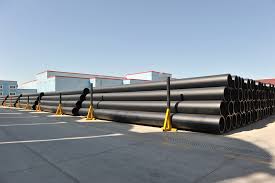Dec . 17, 2024 13:45 Back to list
Complete Guide to PPR Pipes from Leading Manufacturers
The Importance of PPR Pipes in Manufacturing A Comprehensive Overview
In the modern manufacturing landscape, the choice of materials plays a pivotal role in the efficiency, reliability, and sustainability of production processes. One material that has gained significant attention in industrial applications is Polypropylene Random Copolymer (PPR). PPR pipes, known for their durability and corrosion resistance, are increasingly being utilized in various manufacturing setups. This article delves into the characteristics, applications, and advantages of PPR pipes in manufacturing environments.
Understanding PPR Pipes
PPR pipes are made from a type of thermoplastic polymer, specifically designed to provide a robust solution for transporting liquids and gases. They are produced through a process that involves adding random copolymers to polypropylene, resulting in a material that offers enhanced flexibility, strength, and resistance to impact and high temperatures. PPR pipes are typically available in a range of sizes and pressure ratings, making them suitable for various applications in both residential and industrial settings.
Key Characteristics of PPR Pipes
1. Corrosion Resistance One of the standout features of PPR pipes is their resistance to corrosion, unlike metal pipes that can rust over time. This property makes PPR an ideal choice for transporting chemicals, hot water, and other aggressive media without the risk of degradation.
2. Thermal Stability PPR pipes can withstand high temperatures up to 95°C (203°F) without any structural compromise. This thermal stability makes them suitable for hot water supply systems in manufacturing facilities where temperature control is critical.
3. Lightweight and Easy to Install PPR pipes are significantly lighter than their metal counterparts, which simplifies installation and reduces labor costs. The ease of handling also minimizes transportation costs, making them an economical choice for manufacturers.
4. Leak-proof Joints The fusion welding technique used in joining PPR pipes ensures that the joints are leak-proof, providing long-lasting performance without the risk of leaks commonly associated with threaded or glued connections.
5. Sustainability PPR pipes are recyclable, contributing to a more sustainable manufacturing process. Their longevity and efficiency also help reduce the environmental impact associated with maintenance and replacements in infrastructure.
Applications in Manufacturing
PPR pipes are utilized across a wide array of manufacturing environments due to their versatility
ppr pipes in full manufacturer

- Water Supply Systems In many manufacturing plants, the need for reliable water supply systems is paramount. PPR pipes are used for both cold and hot water distribution, ensuring that the essential utility is delivered without interruptions.
- Chemical Transfer Lines Many factories deal with hazardous chemicals that require safe transportation infrastructure. PPR pipes have proven effective for chemical transfer due to their resistance to aggressive substances.
- Air Conditioning and Cooling Systems PPR pipes are also employed in the installation of HVAC systems within industrial facilities, where efficient heat exchange and temperature control are necessary for preserving product quality.
- Fire Protection Systems With fire safety being a critical concern, PPR pipes are increasingly incorporated into fire sprinkler systems. Their ability to resist high temperatures makes them suitable for protecting valuable assets in manufacturing.
Advantages for Manufacturers
The adoption of PPR pipes offers multiple advantages for manufacturers
- Cost-Efficiency While the initial investment in PPR piping may be higher than traditional materials, their long-term durability and low maintenance requirements often lead to significant cost savings over time.
- Reduced Downtime With their reliable performance and minimized risk of leaks, PPR pipes contribute to increased operational efficiency. This reduction in downtime is crucial for maintaining productivity in manufacturing environments.
- Improved Quality of End Products By using PPR pipes for essential supply lines and services, manufacturers can ensure a higher quality of end products. For example, in the food and beverage industry, maintaining high sanitary standards is vital, and PPR pipes can help achieve this goal.
Conclusion
PPR pipes are emerging as a preferred solution in the manufacturing industry due to their unique properties and numerous advantages. Their resistance to corrosion, thermal stability, lightweight nature, and recyclable characteristics position them as a sustainable choice for modern production needs. As industries increasingly focus on efficiency, cost-effectiveness, and sustainability, the role of PPR pipes will likely continue to grow in significance, making them an essential component in contemporary manufacturing strategies.
-
High-Quality PVC Borehole Pipes Durable & Versatile Pipe Solutions
NewsJul.08,2025
-
High-Quality PVC Perforated Pipes for Efficient Drainage Leading Manufacturers & Factories
NewsJul.08,2025
-
High-Quality PVC Borehole Pipes Durable Pipe Solutions by Leading Manufacturer
NewsJul.08,2025
-
High-Quality PVC Borehole Pipes Reliable PVC Pipe Manufacturer Solutions
NewsJul.07,2025
-
High-Quality UPVC Drain Pipes Durable HDPE & Drain Pipe Solutions
NewsJul.07,2025
-
High-Quality Conduit Pipes & HDPE Conduit Fittings Manufacturer Reliable Factory Supply
NewsJul.06,2025

